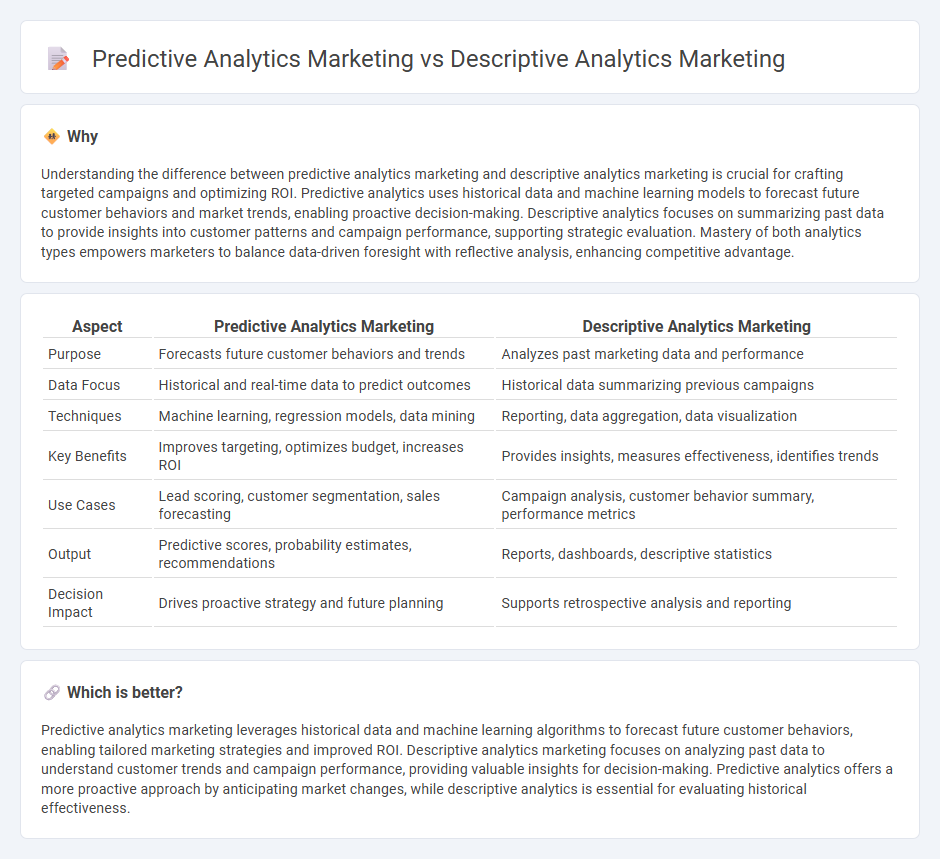
Predictive analytics marketing uses historical data and machine learning algorithms to forecast future customer behaviors and trends, allowing businesses to optimize targeting and tailor campaigns proactively. Descriptive analytics marketing focuses on analyzing past data to understand what happened in previous marketing efforts, providing valuable insights into customer demographics, campaign effectiveness, and sales patterns. Discover more about how these analytics approaches can transform your marketing strategy.
Why it is important
Understanding the difference between predictive analytics marketing and descriptive analytics marketing is crucial for crafting targeted campaigns and optimizing ROI. Predictive analytics uses historical data and machine learning models to forecast future customer behaviors and market trends, enabling proactive decision-making. Descriptive analytics focuses on summarizing past data to provide insights into customer patterns and campaign performance, supporting strategic evaluation. Mastery of both analytics types empowers marketers to balance data-driven foresight with reflective analysis, enhancing competitive advantage.
Comparison Table
| Aspect | Predictive Analytics Marketing | Descriptive Analytics Marketing |
|---|---|---|
| Purpose | Forecasts future customer behaviors and trends | Analyzes past marketing data and performance |
| Data Focus | Historical and real-time data to predict outcomes | Historical data summarizing previous campaigns |
| Techniques | Machine learning, regression models, data mining | Reporting, data aggregation, data visualization |
| Key Benefits | Improves targeting, optimizes budget, increases ROI | Provides insights, measures effectiveness, identifies trends |
| Use Cases | Lead scoring, customer segmentation, sales forecasting | Campaign analysis, customer behavior summary, performance metrics |
| Output | Predictive scores, probability estimates, recommendations | Reports, dashboards, descriptive statistics |
| Decision Impact | Drives proactive strategy and future planning | Supports retrospective analysis and reporting |
Which is better?
Predictive analytics marketing leverages historical data and machine learning algorithms to forecast future customer behaviors, enabling tailored marketing strategies and improved ROI. Descriptive analytics marketing focuses on analyzing past data to understand customer trends and campaign performance, providing valuable insights for decision-making. Predictive analytics offers a more proactive approach by anticipating market changes, while descriptive analytics is essential for evaluating historical effectiveness.
Connection
Predictive analytics marketing uses historical data and machine learning algorithms to forecast future consumer behaviors, enhancing targeted campaign strategies. Descriptive analytics marketing analyzes past performance metrics and customer interactions to provide insights that inform these predictive models. The integration of both analytics enables marketers to make data-driven decisions that optimize customer engagement and ROI.
Key Terms
**Descriptive Analytics Marketing:**
Descriptive analytics marketing involves analyzing historical data to understand past marketing performance, customer behavior, and campaign effectiveness, using tools like dashboards and reporting. It focuses on metrics such as sales trends, website traffic patterns, and customer segmentation to provide actionable insights for decision-making. Explore how descriptive analytics can optimize your marketing strategies and improve ROI.
Data Visualization
Descriptive analytics in marketing utilizes data visualization tools like charts and dashboards to summarize historical customer behavior and campaign performance, enabling marketers to identify trends and patterns effectively. Predictive analytics employs advanced visualizations combined with machine learning models to forecast future customer actions and optimize marketing strategies proactively. Explore more to understand how these analytics approaches transform data visualization in marketing.
Historical Data
Descriptive analytics marketing centers on analyzing historical data to understand past customer behaviors, campaign performance, and market trends, providing a clear picture of what happened and why. Predictive analytics marketing leverages historical data combined with statistical models and machine learning algorithms to forecast future customer actions, sales trends, and marketing outcomes. Explore more about how integrating both analytics approaches can enhance strategic decision-making in marketing.
Source and External Links
Descriptive Analytics: What It Is, How It Works, and Why You Need It - Descriptive analytics is a data-driven technique that analyzes customer behavior and preferences, helping marketers understand how customers interact with a website or product to improve customer experiences and increase conversions.
Descriptive Analytics: Definition, Steps, Examples, and More - It involves analyzing historical data in four steps: identifying key metrics, collecting and aggregating data, analyzing patterns, and presenting insights visually, which supports marketing and business decisions.
What is Descriptive Analytics? - Jaspersoft - Descriptive analytics interprets historical data to identify patterns that can create reports on marketing campaigns, social media engagement, sales trends, and customer feedback to guide strategic marketing efforts.
 dowidth.com
dowidth.com